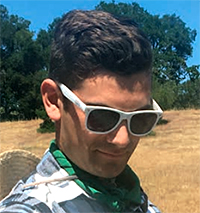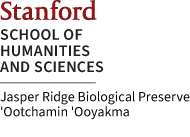Why Neotropical Migrant Birds at Jasper Ridge May Have Ankle Bracelets

Birds are the only terrestrial animal group that connects the globe. This may partly explain why they so captivate the imagination of humans: the US Fish and Wildlife Service in 2013 estimated that there are 47 million bird-watchers in the United States alone. Some birds, like the red knot, travel tens of thousands of miles between the poles each year. Others, like the golden-crowned sparrow, make shorter flights between their breeding and winter grounds. The movement of birds during migration bridges biological systems and ecosystems on a global scale through a massive movement of biomass, so large it can be seen on weather radar.
Jasper Ridge is home to a number of these travelers. Some, called neotropical migrants, reproduce in North America during the summer and spend the winter in Central and South America. Both on a global scale and a "Jasper Ridge scale", neotropical migrants have been dramatically declining. Globally, habitat loss is a major driver of decline. But at Jasper Ridge, returning neotropical migrants over the past decades have experienced an expansion of breeding habitat as sediments continue to accumulate behind Searsville Dam, a process which adds land to the riparian woodland. Yet, the neotropical migrants that breed here continue to decline. My research is aimed at finding out why.
One hypothesis about the driver of population declines comes not from studies of birds, but from turtles. Globally, sea turtle species have been declining due to many factors including increased predation, human disturbance, and by-catch. Conservation of these turtles historically focused on protecting nests to increase the number of young turtles entering the population. However, even after many years of this management strategy local populations failed to grow. In 1987, a study by Crouse et al. (published in Ecology, Vol. 68, No. 5) investigated the demographics of loggerhead sea turtles in the Southeastern United States to determine why populations were not increasing. Their basic premise was that because turtles are long lived, there might be certain periods of survival or reproduction that disproportionately impact the overall population dynamics. They found that the life stage that most affected population growth was the sub-adult stage. This discovery led to a shift in conservation strategies from protecting nests to protecting young adults, which resulted in better outcomes.
This basic principle of using demographics to understand mechanisms for population decline is applicable to birds (and in fact most animals) as well as turtles. Therefore, I am collecting demographic data like age, sex, survival (what is the probability of a bird surviving year to year?), and productivity (what is the average number of offspring an individual produces each breeding season?) by a method called capture-mark-recapture.
The method I use at Jasper Ridge is to put an aluminum band—in effect an ankle bracelet—with a unique number around the bird's leg, in a way that does not negatively impact the birds. The bands come from the Bird Banding Laboratory (BBL) at the United States Geological Survey (USGS), which is the only source of bird bands in the United States in order to avoid duplicating the numbers on the bands. The BBL also provides permits and authorizes researchers to band birds.
Once a bird is banded and flies away, it goes on with its bird life, of course. It finds a mate, makes a nest, lays some eggs, and, oops, it gets caught by me again. In some cases, upon recapture, I see that the bird has a brood patch (it looks kind of like a blister on a bird’s belly), which is a physiological characteristic of female. Brood patches make the transfer of heat from mother to eggs and young more efficient, and indicate that the bird is actively reproducing. After I note this, the bird flies away again and goes back to her bird life. Her eggs hatch and her young quickly develop. Eventually some of the young fledge the nest and fly off. These youngsters fly around, learning about the world and, oops, they get caught by me. I analyze their plumage and molt patterns, which allows me to determine that they are recently fledged birds. Then they fly away and keep on doing bird things. They make their first journey to Central America in the fall and spend the winter in, for example, Costa Rica. The days get longer and the air gets warmer, triggering their return to North America to breed and, oops, they get caught by me again. All of this capture and recapture over time as well as capture and recapture across ages provides the data critical for researchers to estimate survival and reproduction – the two key demographic parameters that control population growth.
Jasper Ridge is an important area for gathering these data. The first comprehensive study of the birds breeding in the riparian woodland in the preserve occurred in the early 1970s and found it had the highest density of breeding land birds anywhere in North America. But, a lot has changed since then as many neotropical migrants have declined. By banding birds to obtain critical demographic information about these populations and communities, it will become possible to test various hypotheses about the mechanisms that have caused these declines. Just as was the case with those loggerhead turtles I mentioned above, this information will hopefully inform conservation work in the future by indicating what life stages conservation efforts should target.
Photo (top): A newly banded male San Francisco Common Yellowthroat (Geothlypis trichas sinuosa) before release. These birds are endemic to the Bay Area and listed as a Species of Special Concern in California.
 David Tattoni is an undergraduate student in the Earth Systems Program and is an experienced and permitted bird bander in North America. His federal permit number is 22109-CO and his CA permit number is 13793. The capture and banding of birds is illegal without such permits. All procedures have been reviewed and approved by Stanford University’s Institutional Animal Care and Use Committee. Please direct any questions directly to David at dtattoni@stanford.edu
David Tattoni is an undergraduate student in the Earth Systems Program and is an experienced and permitted bird bander in North America. His federal permit number is 22109-CO and his CA permit number is 13793. The capture and banding of birds is illegal without such permits. All procedures have been reviewed and approved by Stanford University’s Institutional Animal Care and Use Committee. Please direct any questions directly to David at dtattoni@stanford.edu



